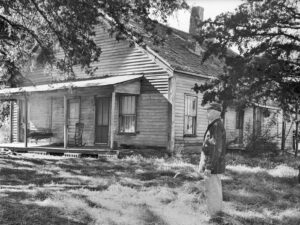Minneola, Kansas, in Franklin County, started as St. Bernard in 1855. The town no longer exists today.
Early in 1855, J.M. Bernard opened a store on his quarter section, a couple of miles east of Centropolis. On March 3, 1855, he was appointed postmaster, and the post office was named St. Bernard after him. That year, the Kansas Territorial Legislature designated St. Bernard as the Franklin County seat. However, the town didn’t grow or prosper.
At this time, Kansas was deciding whether it would become a Free-State or a Slave State. This issue was hot, with many settlers arriving for political reasons. J.M. Bernard was a pro-slavery advocate.
Before long, Bernard made himself obnoxious and threatening one too many times, and a raid by Free-State men was carried out against Bernard and his post office. He was soon induced to leave, and nothing was left of the town. The St. Bernard Post Office was discontinued on November 26, 1858, and renamed Minneola.
In 1857, the Kansas Free-State voters overcame the pro-slavery faction and wanted to move the territorial capital from Lecompton. The legislature then convened at Lawrence to decide on a new location. Perry Fuller, who had successfully established Centropolis as a city, and several associates purchased 14 quarter sections of farmland near Minneola, hoping to expand the small town into the future capital. Around this time, the Centropolis newspaper, the Kansas Leader, was brought to Minneola and renamed the Minneola Statesman. Minneola then became the chief rival of nearby Centropolis, as both hoped to be Kansas’s newly appointed territorial capital.
Fuller, also an Indian Agent, was elected a Territorial Senator and a Territorial Representative. Fuller originally wanted Centropolis to be the capital of Kansas. However, some of Fuller’s business ventures were unsavory, including selling liquor to the Indians, which caused Centropolis to have a bad name. So, he crossed Eight Mile Creek and founded the new town of Minneola.
Bribing the legislature with free town stock and land lots, Perry Fuller successfully got Minneola voted as the new capital on February 10, 1858. However, Kansas Territorial Governor James W. Denver vetoed this choice. Fuller appealed to Jeremiah S. Black, the Attorney General of the United States, who ruled that the legislative bill had violated U.S. statutes and was, therefore, invalid. Despite this, the legislature voted to meet at Minneola on March 22-23, 1858, to draft a new constitution. Following this bill, work began in Minneola, and several buildings were constructed, including a potential governor’s house and a hotel. The city was also planned to be a hub for rail lines.
When the legislators came, many had to camp on the open prairie because there wasn’t enough shelter. The legislature debated throughout the night of March 26-27, 1858, with political leader James Lane not supporting Minneola. Afterward, the legislature moved to adjourn to Leavenworth, Kansas. A later court ruling officially judged the legislative act establishing Minneola as the capital void.
Despite its lost chance as a capital, Minneola maintained its prosperity for a few years, mainly due to the promise of coming railroads. It even briefly served as the county seat. However, after a bad drought, the city began to be dismantled. Eventually, the Statesman newspaper was suspended, and the proposed legislative hall was moved to Ottawa in 1864, where it served various purposes until it was relocated for a second time and destroyed by fire.
Minneola’s post office closed on December 8, 1865, and moved to Centropolis, and in time, its other buildings were demolished.
Nothing remains of the townsite today. The site is on the north and south sides of Stafford Road, between Kentucky and Iowa Roads, on private property.
©Kathy Alexander/Legends of Kansas, updated November 2023.
Also See:
Sources:
Blackmar, Frank W.; Kansas: A Cyclopedia of State History, Vol I; Standard Publishing Company, Chicago, IL 1912.
Cutler, William G; History of Kansas; A. T. Andreas, Chicago, IL, 1883.
Franklin County History
Kansas Post Office History
Wikipedia


